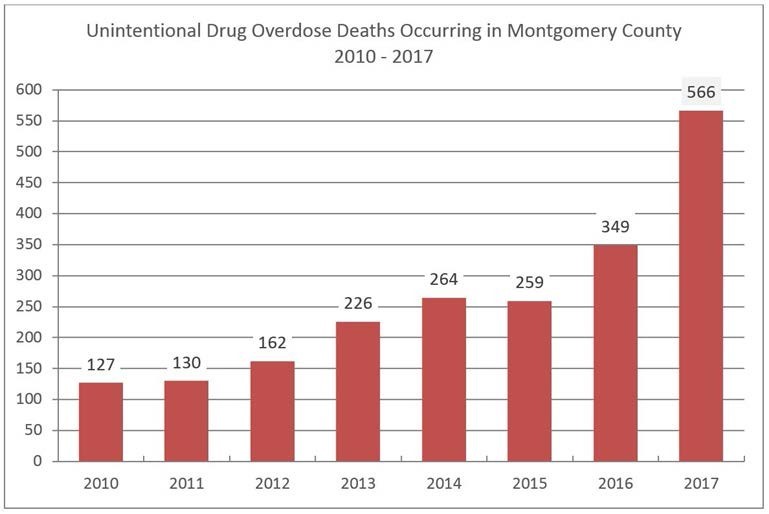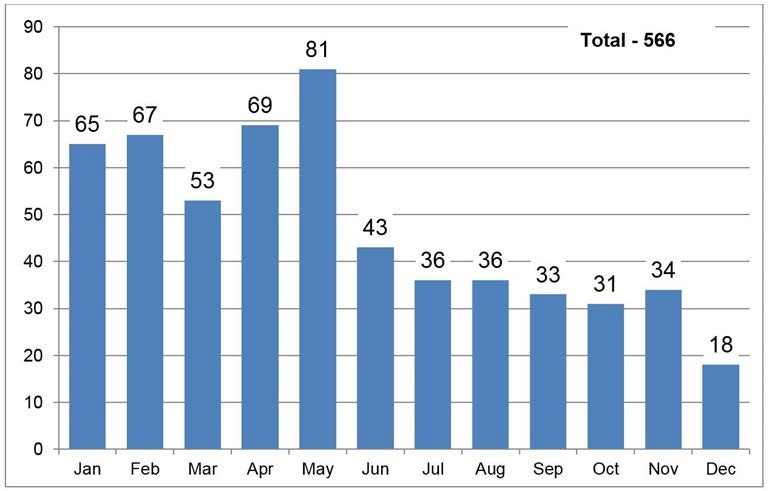By Michael Dohn, MD, MSc, Medical Director, Public Health – Dayton & Montgomery County

The Montgomery County opioid overdose death rate was the highest in Ohio from 2010 through 2016. Accidental opioid overdose deaths continued to climb in 2017. Montgomery County became the face of the opioid epidemic with the publication of “Faces of an Epidemic” in The New Yorker. Projections from the end of 2016 anticipated more than 800 total unintentional overdose deaths in 2017. The opioid situation affected all areas and jurisdictions within Montgomery County, and it was stressing multiple civic sectors, including the criminal justice system, fire and emergency services, the coroner’s office, health care systems, addiction treatment programs, public health, and prevention programs.
This success story highlights the process through which stakeholders in the Montgomery County community initiated a collaborative process to address the opioid situation to accomplish common goals through a collective impact model.
Project Overview
In September 2016, the County Commissioners convened a community-wide forum to request community stakeholders to work together to address the epidemic. Public Health – Dayton & Montgomery County (PHDMC) and Montgomery County Alcohol, Drug Addiction and Mental Health Services (ADAMHS) have taken the lead to coordinate these community-wide efforts.
Under this leadership, community partners have come together to form the Community Overdose Action Team (COAT). The COAT operates under a Collective Impact Model and the National Incident Management System framework. The National Incident Management System framework provides a consistent template for partners to work together to respond to local, state and federal emergencies.
The COAT’s primary goal is to stabilize, then reduce the number of fatal overdoses in Montgomery County. COAT members look for existing gaps in services and explore new ways to combat the drug overdose crisis. Over 200 individuals from participating agencies, along with people in recovery and family members, participate in one of eight branches, each with a different focus area.
Key stakeholders involved with the development of a Community Action Plan and the COAT included Montgomery ADAMHS; local city and county law enforcement; courts and the criminal justice system; fire and emergency services; the county coroner’s office; hospitals and healthcare systems; addiction treatment providers; harm reduction and prevention coalitions; community-based groups; county children’s services; schools of medicine and pharmacy; and insurance companies, among others.
Implementation
The community recognized the need for improved coordination among the various activities relevant to the opioid and drug addiction problem. As a result, PHDMC and ADAMHS provided the organizational leadership to address the opioid situation through a process of community-wide collaborative action and collective impact.
According to the Collective Impact Model, all organizations agreed to the following:
- Work within a common organizational structure.

- Establish a common agenda.
- Share measurement data.
- Adopt mutually reinforcing activities.
- Assure respectful communication.
- Assure continuous communication.
- Serve the community through a systems-based approach.
- Promote shared values.
- Trust each other.
- Use results-based planning.
- Share responsibility.
- Be transparent.
- Commit to excellence.
- Commit to empowering the community.
Involved stakeholders elected to use the Incident Command System as a collaborative structure that is familiar to many local organizations to form the Community Overdose Action Team (COAT).
More than 100 organizations joined the COAT. The branches worked on a monthly action cycle, and the COAT issued monthly incident action plans. Each branch had two co-leads who managed the branch’s meetings and logistics. See the COAT structure and branches in the figure below.


Results
The COAT initiated many activities that rapidly improved cross-sector communication and coordination, including a two-day working conference on sequential intercept mapping focused on the criminal justice system that resulted in changes to standard operations and communication protocols (some of which were instituted before the end of the conference), as well as other system improvements.
The COAT branches’ activities influenced overdose prevention, overdose follow-up visits, referrals to addiction treatment, opioid prescribing, workplace drug policies and programs, school prevention programs, opioid disposal efforts, sober housing capacity, naloxone distribution, harm reduction activities, syringe services, police and fire responses, illegal opioid availability, and common messaging to the community. Learn more in the Community Overdose Action Team 2017 Annual Report.
The unintentional overdose deaths began to fall in June 2017. During the first half of 2018, overdose deaths, overdose emergency department visits, law enforcement overdose calls, and emergency medical services overdose runs all fell 65% or more compared to the same time period in 2017. See more on overdose trends here. While the total overdose deaths in 2017 were fewer than the projections, it is still too many. COAT Branches are continuing their work.
In July 2018, the COAT received an Achievement Award from the National Association of Counties in the category of Human Service. The award honors innovative, effective county government programs that strengthen services for residents.
Lessons Learned
- Collaborative action is effective when partners commit to cooperation in a collective impact model.
- Be prepared to proceed when sufficient organizations are committed to collaborative action, and accept that some stakeholders will not participate.
- Plan for frequent reiteration of the common goals and commitments. (Initially, each branch, steering committee, and backbone support meeting began with a review of the goals, objectives, and agreements of the COAT).
- A collaborative action plan results in synergy that produces solutions that are broader and more innovative than anticipated. As Aristotle said, “The whole is greater than the sum of its parts.”





